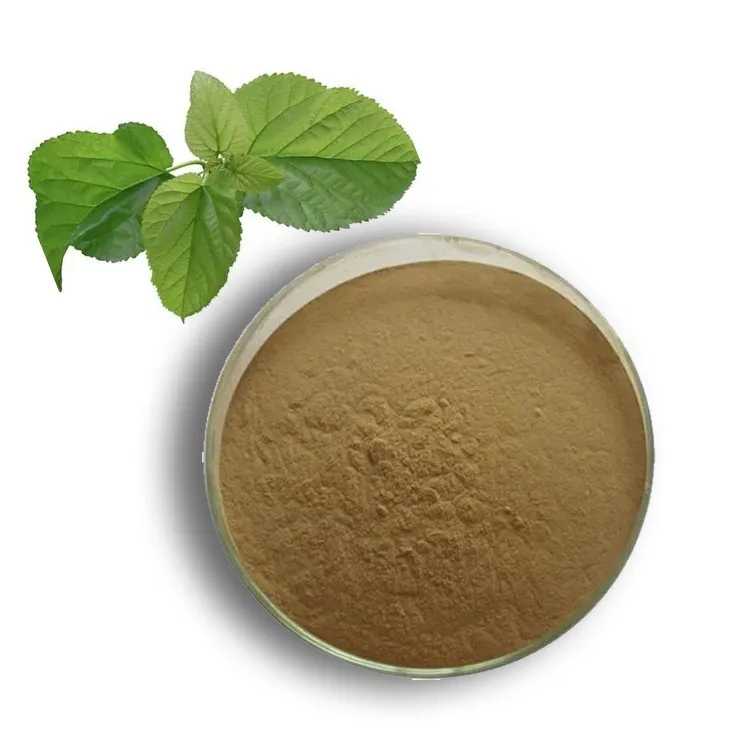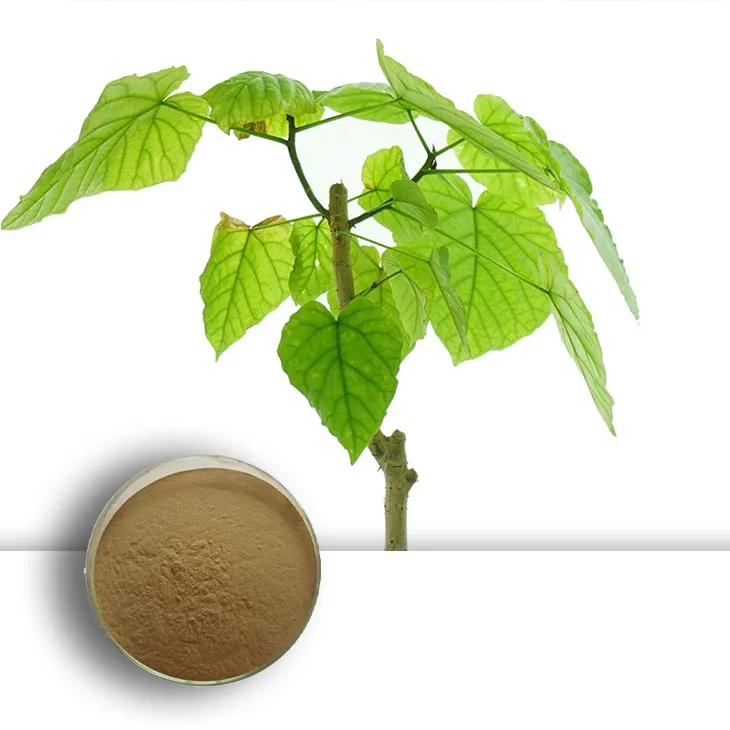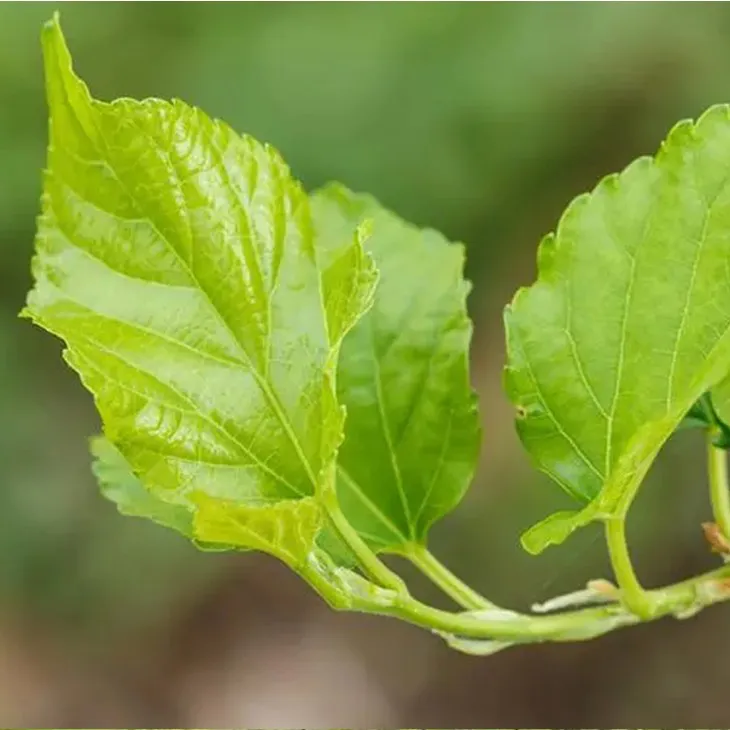- 0086-571-85302990
- sales@greenskybio.com
Optimal Bioavailability of Mulberry Leaf Extract.
2024-11-29

1. Introduction
Mulberry leaf Extract has been gaining increasing attention in recent years due to its potential health benefits. However, the bioavailability of its active components is a crucial factor that determines its effectiveness in vivo. Bioavailability refers to the proportion of a drug or other substance which enters the circulation when introduced into the body and so is able to have an active effect. Understanding and enhancing the bioavailability of Mulberry leaf Extract can lead to better utilization of its medicinal properties.

2. Chemical Composition of Mulberry leaf Extract
Mulberry leaves are rich in various bioactive compounds. One of the major components is 1 - deoxynojirimycin (DNJ). DNJ is a potent α - glucosidase inhibitor, which can slow down the digestion of carbohydrates and thus has potential applications in managing blood sugar levels. It has a unique chemical structure that plays an important role in its biological activity and absorption in the body.
Another important group of compounds in mulberry leaf extract are flavonoids. Flavonoids such as rutin and Quercetin are known for their antioxidant, anti - inflammatory, and cardiovascular - protective properties. These flavonoids have different chemical characteristics compared to DNJ, and their bioavailability may be influenced by various factors such as solubility, stability, and interaction with other substances in the gastrointestinal tract.

3. Factors Affecting Bioavailability
3.1 Solubility
Many of the bioactive compounds in mulberry leaf extract, such as DNJ and flavonoids, have relatively low solubility in water. This low solubility can limit their absorption in the gastrointestinal tract. For example, DNJ is a polar compound, but its solubility in water is not high enough to ensure efficient absorption. Insufficient solubility can lead to a large proportion of the compound remaining in the lumen of the gut and being excreted without being absorbed into the bloodstream.
3.2 Stability
The stability of mulberry leaf extract components during digestion is also a significant factor. In the acidic environment of the stomach, some of the bioactive compounds may be degraded or chemically modified. For instance, flavonoids may be oxidized or hydrolyzed, which can reduce their bioactivity and bioavailability. Moreover, the presence of enzymes in the gut can also interact with the extract components, either enhancing or reducing their stability.
3.3 Interaction with Food and Other Substances
When mulberry leaf extract is consumed, it can interact with food components or other medications. For example, if it is taken with a high - fat meal, the fat may affect the absorption of the extract by altering the solubility or permeability of the gut membrane. Similarly, if taken with certain drugs that have similar target proteins or metabolic pathways, there may be competition for absorption or metabolism, which can influence the bioavailability of the mulberry leaf extract.

4. Current Research on Enhancing Bioavailability
4.1 Nanoparticle - based Delivery Systems
Nanoparticle - based delivery systems have emerged as a promising approach to enhance the bioavailability of mulberry leaf extract. Nanoparticles can encapsulate the bioactive compounds, protecting them from degradation in the gastrointestinal tract. For example, liposomes can be used to encapsulate DNJ. Liposomes are spherical vesicles composed of phospholipid bilayers, which can mimic the cell membrane structure. They can increase the solubility of DNJ by encapsulating it in a hydrophobic core or at the interface of the bilayer. Moreover, nanoparticles can also enhance the cellular uptake of the extract components. By reducing the size of the particles to the nanoscale, they can be more easily taken up by cells through endocytosis or other mechanisms.
4.2 Prodrug Design
Prodrug design is another strategy to improve the bioavailability of mulberry leaf extract. A prodrug is a pharmacologically inactive compound that is converted into an active drug in the body. For instance, chemically modifying DNJ to form a prodrug can change its solubility and stability properties. The prodrug can be designed to be more soluble in water, which can improve its absorption in the gut. Once absorbed, it can be enzymatically converted back to the active DNJ form in the body, thus enhancing its bioavailability.
4.3 Formulation with Bioenhancers
Combining mulberry leaf extract with bioenhancers is also an effective method. Bioenhancers are substances that can increase the bioavailability of other drugs or bioactive compounds. For example, some natural compounds such as piperine have been shown to enhance the absorption of flavonoids. When mulberry leaf extract is formulated with piperine, it may lead to increased absorption of its flavonoid components. The mechanism may involve modulation of intestinal transporters or alteration of the gut membrane permeability.
5. In - vivo and In - vitro Studies
5.1 In - vitro Studies
In - vitro studies play an important role in understanding the bioavailability of mulberry leaf extract. These studies are often carried out using cell culture models. For example, using intestinal epithelial cell lines, researchers can study the uptake and transport of mulberry leaf extract components. They can investigate how different factors such as nanoparticle encapsulation or prodrug modification affect the cellular uptake of DNJ or flavonoids. In - vitro studies also allow for the evaluation of the stability of the extract components under simulated gastrointestinal conditions, such as different pH levels and enzyme activities.
5.2 In - vivo Studies
In - vivo studies are essential for validating the results obtained from in - vitro studies. Animal models are commonly used in in - vivo research on mulberry leaf extract bioavailability. For example, in diabetic mice models, researchers can study the effect of different formulations of mulberry leaf extract on blood sugar control. By comparing the blood levels of DNJ or other bioactive compounds after administration of different formulations (such as nanoparticle - encapsulated extract or prodrug - based formulations), they can determine which formulation has the best bioavailability and the most significant therapeutic effect. In addition, in - vivo studies can also take into account the complex physiological environment in the body, including factors such as metabolism, distribution, and excretion.
6. Challenges and Future Directions
Despite the progress made in enhancing the bioavailability of mulberry leaf extract, there are still several challenges. One of the challenges is the lack of standardized methods for evaluating bioavailability. Different research groups may use different experimental models and analytical methods, which can lead to inconsistent results. Another challenge is the potential toxicity of some of the delivery systems or formulation additives. For example, nanoparticles may have potential cytotoxicity if not properly designed or if they accumulate in the body at high levels.
For future directions, more research is needed to develop standardized evaluation methods for bioavailability. This will help in comparing the results of different studies more accurately. Additionally, exploring novel and safe delivery systems and formulation strategies is crucial. For example, developing biodegradable nanoparticles or using natural bioenhancers with low toxicity. Moreover, further studies are required to understand the long - term effects of enhanced bioavailability of mulberry leaf extract on human health, especially in terms of potential drug - drug interactions and chronic toxicity.
7. Conclusion
In conclusion, the bioavailability of mulberry leaf extract is a complex and important area of research. Understanding the chemical composition of the extract and the factors affecting its bioavailability is the first step towards enhancing its effectiveness. Current research on nanoparticle - based delivery systems, prodrug design, and formulation with bioenhancers shows promising potential for improving the bioavailability of mulberry leaf extract. However, there are still challenges to overcome, and future research should focus on addressing these challenges and further exploring the potential of mulberry leaf extract for better health benefits.
FAQ:
What factors affect the bioavailability of mulberry leaf extract?
The bioavailability of mulberry leaf extract can be affected by several factors. One key factor is its chemical composition. For example, the types and amounts of active compounds present in the extract, such as flavonoids and alkaloids, can influence how well it is absorbed by the body. The form of the extract also matters. If it is in a poorly soluble form, it may have lower bioavailability. Additionally, the presence of other substances in the gastrointestinal tract, such as food components or drugs, can interact with the mulberry leaf extract and either enhance or reduce its bioavailability.
How can the delivery systems enhance the bioavailability of mulberry leaf extract?
Delivery systems play a crucial role in enhancing the bioavailability of mulberry leaf extract. Nanoparticle - based delivery systems, for instance, can increase solubility and improve the stability of the extract. They can protect the active compounds from degradation in the digestive tract and enhance their absorption across the intestinal barrier. Lipid - based delivery systems are also effective. They can encapsulate the extract, making it more lipophilic and thus more easily absorbed by the cells lining the intestine. Microemulsions are another option, which can improve the dispersion of the extract and increase its contact with the absorptive surfaces in the gut.
What are the main health benefits associated with improved bioavailability of mulberry leaf extract?
Improved bioavailability of mulberry leaf extract can lead to several health benefits. It may enhance its antioxidant activity more effectively. This means it can better combat oxidative stress in the body, which is linked to various chronic diseases such as heart disease and cancer. It can also potentially improve blood sugar regulation. With better bioavailability, the extract may be more effective in modulating glucose metabolism, which is beneficial for diabetics or those at risk of developing diabetes. Additionally, it may have a more pronounced anti - inflammatory effect, helping to reduce inflammation in the body.
Are there any side effects related to increasing the bioavailability of mulberry leaf extract?
Generally, when increasing the bioavailability of mulberry leaf extract through proper means, there are no significant side effects. However, in some cases, if the bioavailability is enhanced too much, it could potentially lead to an overdose of certain active compounds. For example, if the levels of alkaloids become too high due to excessive absorption, it might cause mild gastrointestinal discomfort such as nausea or diarrhea. But this is rare and usually only occurs when very large amounts are consumed or improper enhancement methods are used.
How is the bioavailability of mulberry leaf extract measured?
The bioavailability of mulberry leaf extract can be measured through several methods. One common approach is to conduct pharmacokinetic studies. This involves administering the extract to test subjects and then measuring the levels of its active compounds in the blood over time. The area under the curve (AUC) of the concentration - time profile is often used as an indicator of bioavailability. Another method is to study the excretion of the extract and its metabolites in urine or feces. By analyzing the amount excreted and the time it takes, some information about bioavailability can be obtained. In vitro models, such as cell culture models of intestinal absorption, can also be used to estimate the potential bioavailability before in vivo studies.
Related literature
- Bioavailability and Metabolism of Mulberry Leaf Bioactive Compounds"
- "Enhancing Bioavailability of Herbal Extracts: The Case of Mulberry Leaf"
- "Delivery Systems for Mulberry Leaf Extract: A Strategy for Optimal Bioavailability"
- ▶ Hesperidin
- ▶ citrus bioflavonoids
- ▶ plant extract
- ▶ lycopene
- ▶ Diosmin
- ▶ Grape seed extract
- ▶ Sea buckthorn Juice Powder
- ▶ Beetroot powder
- ▶ Hops Extract
- ▶ Artichoke Extract
- ▶ Reishi mushroom extract
- ▶ Astaxanthin
- ▶ Green Tea Extract
- ▶ Curcumin Extract
- ▶ Horse Chestnut Extract
- ▶ Other Problems
- ▶ Boswellia Serrata Extract
- ▶ Resveratrol Extract
- ▶ Marigold Extract
- ▶ Grape Leaf Extract
- ▶ blog3
- ▶ blog4
-
Standard - process green tea extract.
2024-11-29
-
100% Organic Calendula Extract.
2024-11-29
-
Lavender Extract
2024-11-29
-
Garcinia Cambogia Extract
2024-11-29
-
Lily extract
2024-11-29
-
Selenium yeast
2024-11-29
-
Natural grape seed extract
2024-11-29
-
Cranberry Extract
2024-11-29
-
Saffron Extract Powder
2024-11-29
-
Epimedium extract powder
2024-11-29
-
Pueraria Lobata Extract
2024-11-29
-
Mangosteen extract powder
2024-11-29





















